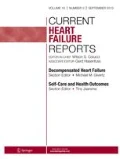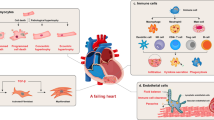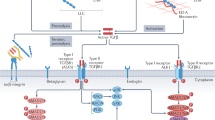Abstract
Neuregulin-1 (NRG-1), a ligand of receptor tyrosine kinases of the ErbB family, plays a critical role in cardiovascular development and maintenance of adult heart function. Results from cellular, animal, and clinical experiments have shown NRG-1 to be a promising drug candidate for restoring cardiac function after cardiac injury. Various mechanisms have been suggested to be involved in this process, such as improving sarcomeric structure or cell–cell adhesion, promoting proliferation and survival of cardiac myocytes, balancing Ca2+ homeostasis, modulating inotropic effects, promoting angiogenesis, and preventing atherosclerosis. However, the contribution of these effects to the restoration of cardiac function remains to be estimated, and it may depend on the specific events that led to heart failure. Meanwhile, distinct and crossed signaling pathways downstream of NRG-1 may play a role in these underlying mechanisms, resulting in a complicated network of signaling mediating the function of NRG-1.

Similar content being viewed by others
References
Papers of particular interest, published recently have been highlighted as: • Of importance •• Of major importance
Britsch S: The neuregulin-I/ErbB signaling system in development and disease. Adv Anat Embryol Cell Biol 2007, 190:1–65.
Meyer D, Yamaai T, Garratt A, et al.: Isoform-specific expression and function of neuregulin. Development 1997, 124:3575–3586.
Falls DL: Neuregulins: functions, forms, and signaling strategies. Exp Cell Res 2003, 284:14–30.
Bublil EM, Yarden Y: The EGF receptor family: spearheading a merger of signaling and therapeutics. Curr Opin Cell Biol 2007, 19:124–134.
• Pentassuglia L, Sawyer DB: The role of Neuregulin-1beta/ErbB signaling in the heart. Exp Cell Res 2009, 315:627–637. This article reviews recent advances in understanding the role of NRG-1 in the cardiac development and maintenance of heart function.
Meyer D, Birchmeier C: Multiple essential functions of neuregulin in development. Nature 1995, 378:386–390.
Gassmann M, Casagranda F, Orioli D, et al.: Aberrant neural and cardiac development in mice lacking the ErbB4 neuregulin receptor. Nature 1995, 378:390–394.
Lee KF, Simon H, Chen H, et al.: Requirement for neuregulin receptor erbB2 in neural and cardiac development. Nature 1995, 378:394–398.
Crone SA, Zhao YY, Fan L, et al.: ErbB2 is essential in the prevention of dilated cardiomyopathy. Nat Med 2002, 8:459–465.
García-Rivello H, Taranda J, Said M, et al.: Dilated cardiomyopathy in Erb-b4-deficient ventricular muscle. Am J Physiol Heart Circ Physiol 2005, 289:H1153–H1160.
Zhao YY, Sawyer DR, Baliga RR, et al.: Neuregulins promote survival and growth of cardiac myocytes. Persistence of ErbB2 and ErbB4 expression in neonatal and adult ventricular myocytes. J Biol Chem 1998, 273:10261–10269.
Liu X, Gu X, Li Z, et al.: Neuregulin-1/erbB-activation improves cardiac function and survival in models of ischemic, dilated, and viral cardiomyopathy. J Am Coll Cardiol 2006, 48:1438–1447.
•• Bersell K, Arab S, Haring B, Kühn B: Neuregulin1/ErbB4 signaling induces cardiomyocyte proliferation and repair of heart injury. Cell 2009, 138: 257–270. This study first reported on NRG-1-induced proliferation of differentiated cardiomyocytes and further emphasized the therapeutic effects of NRG-1 on ischemic heart failure.
Rohrbach S, Niemann B, Silber RE, Holtz J: Neuregulin receptors erbB2 and erbB4 in failing human myocardium—depressed expression and attenuated activation. Basic Res Cardiol 2005, 100:240–249.
Lemmens K, Doggen K, De Keulenaer GW: Role of neuregulin-1/ErbB signaling in cardiovascular physiology and disease: implications for therapy of heart failure. Circulation 2007, 116:954–960.
•• Gao R, Zhang J, Cheng L, et al.: A phase II, randomized, double-blind, multi-center, based on standard therapy, placebo-controlled study of the efficacy and safety of recombinant human neuregulin-1 (rhNRG-1) in patients with chronic heart failure (CHF). J Am Coll Cardiol (In press). This article provides the first report demonstrating the therapeutic role of NRG-1 for the treatment of chronic heart failure in humans. Recombinant NRG-1 improved the cardiac function of patients with congestive heart failure by increasing left ventricular ejection fraction percentage, and showed a capability of anti-remodeling by decreasing end-systolic volume and end-diastolic volume compared with pretreatment.
Baliga RR, Pimental DR, Zhao YY, et al.: NRG-1-induced cardiomyocyte hypertrophy. Role of PI-3-kinase, p70(S6K), and MEK-MAPK-RSK. Am J Physiol 1999, 277:H2026–H2037.
Peng X, Kraus MS, Wei H, et al.: Inactivation of focal adhesion kinase in cardiomyocytes promotes eccentric cardiac hypertrophy and fibrosis in mice. J Clin Invest 2006, 116:217–227.
Peng X, Wu X, Druso JE, et al.: Cardiac developmental defects and eccentric right ventricular hypertrophy in cardiomyocyte focal adhesion kinase (FAK) conditional knockout mice. Proc Natl Acad Sci U S A 2008, 105:6638–6643.
Kovacic-Milivojević B, Roediger F, Almeida EA, et al.: Focal adhesion kinase and p130Cas mediate both sarcomeric organization and activation of genes associated with cardiac myocyte hypertrophy. Mol Biol Cell 2001, 12:2290–2307.
Mansour H, de Tombe PP, Samarel AM, Russell B: Restoration of resting sarcomere length after uniaxial static strain is regulated by protein kinase Cepsilon and focal adhesion kinase. Circ Res 2004, 94:642–649.
Kuramochi Y, Guo X, Sawyer DB: Neuregulin activates erbB2-dependent src/FAK signaling and cytoskeletal remodeling in isolated adult rat cardiac myocytes. J Mol Cell Cardiol 2006, 41:228–235.
Willey CD, Balasubramanian S, Rodríguez Rosas MC, et al.: Focal complex formation in adult cardiomyocytes is accompanied by the activation of beta3 integrin and c-Src. J Mol Cell Cardiol 2003, 35:671–683.
Scruggs SB, Hinken AC, Thawornkaiwong A, et al.: Ablation of ventricular myosin regulatory light chain phosphorylation in mice causes cardiac dysfunction in situ and affects neighboring myofilament protein phosphorylation. J Biol Chem 2009, 284:5097–5106.
Dumka D, Talent J, Akopova I, et al.: E22K mutation of RLC that causes familial hypertrophic cardiomyopathy in heterozygous mouse myocardium: effect on cross-bridge kinetics. Am J Physiol Heart Circ Physiol 2006, 291:H2098–H2106.
Aoki H, Sadoshima J, Izumo S: Myosin light chain kinase mediates sarcomere organization during cardiac hypertrophy in vitro. Nat Med 2000, 6:183–188.
• Seguchi O, Takashima S, Yamazaki S, et al.: A cardiac myosin light chain kinase regulates sarcomere assembly in the vertebrate heart. J Clin Invest 2007, 117:2812–2824. This study provided the first report on the identification of cMLCK from human myocardia and further demonstrated that knockdown of cMLCK expression in cardiomyocytes results in immature sarcomere structures.
• Chan JY, Takeda M, Briggs LE, et al.: Identification of cardiac-specific myosin light chain kinase. Circ Res 2008, 102:571–580. This study reports that Nkx2-5 regulated cMLCK expression and further demonstrates that cMLCK modulate MLC2 phosphorylation, sarcomere organization, and cardiomyocytes contraction.
Wang Z, Xu G, Wu Y, et al.: Neuregulin-1 promotes cardiomyocyte differentiation of genetically engineered embryonic stem cell clones. BMB Rep 2008, 41:699–704.
Wang Z, Xu G, Wu Y, et al.: Neuregulin-1 enhances differentiation of cardiomyocytes from embryonic stem cells. Med Biol Eng Comput 2009, 47:41–48.
Pasumarthi KB, Field LJ: Cardiomyocyte cell cycle regulation. Circ Res 2002, 90:1044–1054.
Schneider JW, Chang AY, Rocco TP: Cardiotoxicity in signal transduction therapeutics: erbB2 antibodies and the heart. Semin Oncol 2001, 28:18–26.
Kuramochi Y, Lim CC, Guo X, et al.: Myocyte contractile activity modulates norepinephrine cytotoxicity and survival effects of neuregulin-1beta. Am J Physiol Cell Physiol 2004, 286:C222–C229.
Okoshi K, Nakayama M, Yan X, et al.: Neuregulins regulate cardiac parasympathetic activity: muscarinic modulation of beta-adrenergic activity in myocytes from mice with neuregulin-1 gene deletion. Circulation 2004, 110:713–717.
Fukazawa R, Miller TA, Kuramochi Y, et al.: Neuregulin-1 protects ventricular myocytes from anthracycline-induced apoptosis via erbB4-dependent activation of PI3-kinase/Akt. J Mol Cell Cardiol 2003, 35:1473–1479.
Miao W, Luo Z, Kitsis RN, Walsh K: Intracoronary, adenovirus-mediated Akt gene transfer in heart limits infarct size following ischemia-reperfusion injury in vivo. J Mol Cell Cardiol 2000, 32:2397–2402.
Fujio Y, Nguyen T, Wencker D, et al.: Akt promotes survival of cardiomyocytes in vitro and protects against ischemia-reperfusion injury in mouse heart. Circulation 2000, 101:660–667.
Das S, Cordis GA, Maulik N, Das DK: Pharmacological preconditioning with resveratrol: role of CREB-dependent Bcl-2 signaling via adenosine A3 receptor activation. Am J Physiol Heart Circ Physiol 2005, 288:H328–H235.
Dhanasekaran A, Gruenloh SK, Buonaccorsi JN, et al.: Multiple antiapoptotic targets of the PI3K/Akt survival pathway are activated by epoxyeicosatrienoic acids to protect cardiomyocytes from hypoxia/anoxia. Am J Physiol Heart Circ Physiol 2008, 294:H724–H735.
Kubalova Z, Terentyev D, Viatchenko-Karpinski S, et al.: Abnormal intrastore calcium signaling in chronic heart failure. Proc Natl Acad Sci U S A 2005, 102:14104–14109.
Go LO, Moschella MC, Watras J, et al.: Differential regulation of two types of intracellular calcium release channels during end-stage heart failure. J Clin Invest 1995, 95:888–894.
Pathak A, del Monte F, Zhao W, et al.: Enhancement of cardiac function and suppression of heart failure progression by inhibition of protein phosphatase 1. Circ Res 2005, 96:756–766.
Jiang MT, Lokuta AJ, Farrell EF, et al.: Abnormal Ca2+ release, but normal ryanodine receptors, in canine and human heart failure. Circ Res 2002, 91:1015–1022.
MacDougall LK, Jones LR, Cohen P: Identification of the major protein phosphatases in mammalian cardiac muscle which dephosphorylate phospholamban. Eur J Biochem 1991, 196:725–734.
Verboomen H, Wuytack F, De Smedt H, et al.: Functional difference between SERCA2a and SERCA2b Ca2+ pumps and their modulation by phospholamban. Biochem J 1992, 286:591–595.
Gupta RC, Mishra S, Rastogi S, et al.: Cardiac SR-coupled PP1 activity and expression are increased and inhibitor 1 protein expression is decreased in failing hearts. Am J Physiol Heart Circ Physiol 2003, 285:H2373–H2381.
El-Armouche A, Rau T, Zolk O, et al.: Evidence for protein phosphatase inhibitor-1 playing an amplifier role in beta-adrenergic signaling in cardiac myocytes. FASEB J 2003, 17:437–439.
Lemmens K, Fransen P, Sys SU, et al.: Neuregulin-1 induces a negative inotropic effect in cardiac muscle: role of nitric oxide synthase. Circulation 2004, 109:324–326.
Amin DN, Hida K, Bielenberg DR, Klagsbrun M: Tumor endothelial cells express epidermal growth factor receptor (EGFR) but not ErbB3 and are responsive to EGF and to EGFR kinase inhibitors. Cancer Res 2006, 66:2173–2180.
Iivanainen E, Paatero I, Heikkinen SM, et al.: Intra- and extracellular signaling by endothelial neuregulin-1. Exp Cell Res 2007, 313:2896–2909.
Panutsopulos D, Arvanitis DL, Tsatsanis C, et al.: Expression of heregulin in human coronary atherosclerotic lesions. J Vasc Res 2005, 42:463–474.
Sigala F, Georgopoulos S, Papalambros E, et al.: Heregulin, cysteine rich-61 and matrix metalloproteinase 9 expression in human carotid atherosclerotic plaques: relationship with clinical data. Eur J Vasc Endovasc Surg 2006, 32:238–245.
Xu G, Watanabe T, Iso Y, et al.: Preventive effects of heregulin-beta1 on macrophage foam cell formation and atherosclerosis. Circ Res 2009, 105:500–510.
Disclosure
No potential conflicts of interest relevant to this article were reported.
Author information
Authors and Affiliations
Corresponding author
Rights and permissions
About this article
Cite this article
Jiang, Z., Zhou, M. Neuregulin Signaling and Heart Failure. Curr Heart Fail Rep 7, 42–47 (2010). https://doi.org/10.1007/s11897-010-0003-y
Published:
Issue Date:
DOI: https://doi.org/10.1007/s11897-010-0003-y




